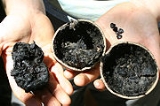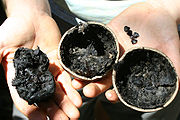
Crescentia alata
Encyclopedia
Crescentia alata is a species in the trumpet-flower family Bignoniaceae
, native to southern Mexico
and Central America
south to Costa Rica
.
It is a small tree
growing to 8 m tall. It has hard, cannonball-like fruit 7-10 cm diameter, that are difficult to break into. It is believed that these fruit characteristics evolved as a defense mechanism against seed predation
. However, it seems to be a counter-productive strategy, as the seeds inside the fruits never germinate unless the fruits are broken open, and with the exception of horses and humans, no animals break open the fruits.
While it has been observed that domestic horses may smash the fruit with their hooves and eat the pulp and seeds (suggesting that they may serve as seed distribution vectors), horses were only very recently (in evolution
ary time) introduced to the native range of C. alata, which implies that C. alata evolved thick-walled, impenetrable fruits long before the introduction of horses to its native range. So the question remains: how did C. alata evolve a defense mechanism (impenetrable fruits) that entirely prevents the germination of its seeds?.
Daniel Janzen
suggested that Gomphothere
s (extinct elephant-like animals) may have previously been responsible for the dispersal of C. alata seeds. With their extinction, C. alata became threatened with the possibility of habitat loss and suffered an extremely limited ability to migrate, but the introduction of a new vector, in the form of domestic horses, has allowed the species to maintain its viability. C. alata is, not surprisingly, most often found in open areas, such as pastures and fields. It is also cultivated for its gourd-like fruits, which may be hollowed and dried and used as containers for food and drink.
The fruit plays a role in the Popol Vuh
(book of myths of the Mayan civilization). After the first generation of hero twins, 1 Hunajpu and 7 Hunajpu, fail and are killed in the ball game in Xibalba
, the demonic Xibalbans hang their skull in this tree. This is presumably a mythic justification for the resemblance of the fruit to skulls and the carrion smell of the tree in flower (scientifically justified because it is pollinated by flies). The skull later spits in the hand of the Xibalban princess Ixquic, thus impregnating her and begetting the second, successful generation of Maya Hero Twins
.
The seeds are edible and high in protein with a licorice-like sweet taste, used in Honduras
, El Salvador
and Nicaragua
to make a kind of horchata
called Semilla de Jicaro.

Bignoniaceae
The Bignoniaceae, or Trumpet Creeper Family, is a family of flowering plants comprising about 650-750 species in 116-120 genera. Members of the family are mostly trees and lianas , shrubs and more rarely herbaceous plants. As climber plants, they are twine climbers or tendril climbers, and rarely...
, native to southern Mexico
Mexico
The United Mexican States , commonly known as Mexico , is a federal constitutional republic in North America. It is bordered on the north by the United States; on the south and west by the Pacific Ocean; on the southeast by Guatemala, Belize, and the Caribbean Sea; and on the east by the Gulf of...
and Central America
Central America
Central America is the central geographic region of the Americas. It is the southernmost, isthmian portion of the North American continent, which connects with South America on the southeast. When considered part of the unified continental model, it is considered a subcontinent...
south to Costa Rica
Costa Rica
Costa Rica , officially the Republic of Costa Rica is a multilingual, multiethnic and multicultural country in Central America, bordered by Nicaragua to the north, Panama to the southeast, the Pacific Ocean to the west and the Caribbean Sea to the east....
.
It is a small tree
Tree
A tree is a perennial woody plant. It is most often defined as a woody plant that has many secondary branches supported clear of the ground on a single main stem or trunk with clear apical dominance. A minimum height specification at maturity is cited by some authors, varying from 3 m to...
growing to 8 m tall. It has hard, cannonball-like fruit 7-10 cm diameter, that are difficult to break into. It is believed that these fruit characteristics evolved as a defense mechanism against seed predation
Seed predation
Seed predation, often referred to as granivory, is a type of plant-animal interaction in which granivores feed on the seeds of plants as a main or exclusive food source, in many cases leaving the seeds damaged and not viable...
. However, it seems to be a counter-productive strategy, as the seeds inside the fruits never germinate unless the fruits are broken open, and with the exception of horses and humans, no animals break open the fruits.
While it has been observed that domestic horses may smash the fruit with their hooves and eat the pulp and seeds (suggesting that they may serve as seed distribution vectors), horses were only very recently (in evolution
Evolution
Evolution is any change across successive generations in the heritable characteristics of biological populations. Evolutionary processes give rise to diversity at every level of biological organisation, including species, individual organisms and molecules such as DNA and proteins.Life on Earth...
ary time) introduced to the native range of C. alata, which implies that C. alata evolved thick-walled, impenetrable fruits long before the introduction of horses to its native range. So the question remains: how did C. alata evolve a defense mechanism (impenetrable fruits) that entirely prevents the germination of its seeds?.
Daniel Janzen
Daniel Janzen
Daniel Hunt Janzen is an evolutionary ecologist, naturalist, and conservationist and the son of a previous Director of the US Fish and Wildlife Service...
suggested that Gomphothere
Gomphothere
Gomphotheriidae is a diverse taxonomic family of extinct elephant-like animals , called gomphotheres. They were widespread in North America during the Miocene and Pliocene epochs, 12-1.6 million years ago. Some lived in parts of Eurasia, Beringia and, following the Great American Interchange,...
s (extinct elephant-like animals) may have previously been responsible for the dispersal of C. alata seeds. With their extinction, C. alata became threatened with the possibility of habitat loss and suffered an extremely limited ability to migrate, but the introduction of a new vector, in the form of domestic horses, has allowed the species to maintain its viability. C. alata is, not surprisingly, most often found in open areas, such as pastures and fields. It is also cultivated for its gourd-like fruits, which may be hollowed and dried and used as containers for food and drink.
The fruit plays a role in the Popol Vuh
Popol Vuh
Popol Vuh is a corpus of mytho-historical narratives of the Post Classic Quiché kingdom in Guatemala's western highlands. The title translates as "Book of the Community," "Book of Counsel," or more literally as "Book of the People."...
(book of myths of the Mayan civilization). After the first generation of hero twins, 1 Hunajpu and 7 Hunajpu, fail and are killed in the ball game in Xibalba
Xibalba
Xibalba , roughly translated as "place of fear", is the name of the underworld in Maya mythology, ruled by the Maya death gods and their helpers. In 16th-century Verapaz, the entrance to Xibalba was traditionally held to be a cave in the vicinity of Cobán, Guatemala. According to some of the...
, the demonic Xibalbans hang their skull in this tree. This is presumably a mythic justification for the resemblance of the fruit to skulls and the carrion smell of the tree in flower (scientifically justified because it is pollinated by flies). The skull later spits in the hand of the Xibalban princess Ixquic, thus impregnating her and begetting the second, successful generation of Maya Hero Twins
Maya Hero Twins
The Maya Hero Twins are the central figures of a narrative included within the colonial Quiché document called Popol Vuh, and constituting the oldest Maya myth to have been preserved in its entirety. Called Hunahpu and Xbalanque in Quiché, the Twins have also been identified in the art of the...
.
The seeds are edible and high in protein with a licorice-like sweet taste, used in Honduras
Honduras
Honduras is a republic in Central America. It was previously known as Spanish Honduras to differentiate it from British Honduras, which became the modern-day state of Belize...
, El Salvador
El Salvador
El Salvador or simply Salvador is the smallest and the most densely populated country in Central America. The country's capital city and largest city is San Salvador; Santa Ana and San Miguel are also important cultural and commercial centers in the country and in all of Central America...
and Nicaragua
Nicaragua
Nicaragua is the largest country in the Central American American isthmus, bordered by Honduras to the north and Costa Rica to the south. The country is situated between 11 and 14 degrees north of the Equator in the Northern Hemisphere, which places it entirely within the tropics. The Pacific Ocean...
to make a kind of horchata
Horchata
Horchata or orxata is the name of several kinds of traditional beverage, made of ground almonds, sesame seeds, rice, barley, or tigernuts .-Etymology:...
called Semilla de Jicaro.


